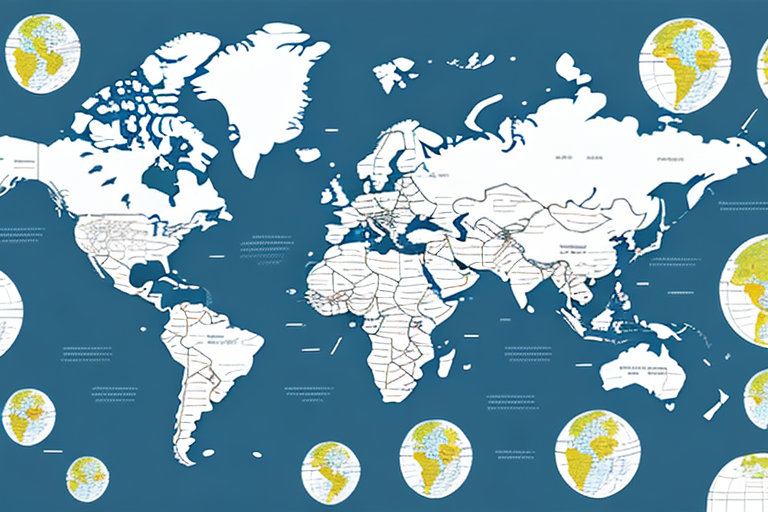Understanding UPS International Package Shipping Rates
As a business owner, shipping your products domestically is one thing, but when it comes to international shipping, there are many complexities to consider. One of the most crucial aspects of international shipping is the cost. In this article, we provide a detailed guide to understanding UPS international package shipping rates. We cover the factors that affect international shipping rates, how to calculate them, the impact of package weight and dimensions, and tips to reduce your shipping rates. We also discuss common mistakes to avoid, the benefits of using UPS for your international package shipping needs, how to track your shipments, and the future of international package shipping with UPS.
Factors That Affect UPS International Package Shipping Rates
UPS international package shipping rates are determined by various factors, including the origin and destination of the package, package weight and dimensions, package value, and the selected shipping service. The shipping service plays a crucial role in determining the rates. UPS offers various shipping services such as UPS Worldwide Express, UPS Worldwide Expedited, and UPS Worldwide Saver, among others, each with different rates and delivery times.
Another factor influencing UPS international package shipping rates is the type of package being shipped. For example, hazardous materials or oversized packages may incur additional fees. Additionally, the time of year can impact shipping rates, with peak seasons such as the holiday season often resulting in higher rates due to increased demand.
According to UPS's [2023 Global Shipping Study](https://www.ups.com/us/en/services/global.page), efficient management of these factors can lead to significant cost savings and improved delivery performance.
How to Calculate UPS International Package Shipping Rates
Calculating UPS international package shipping rates involves considering various factors such as package weight and dimensions, origin and destination, package value, and the chosen shipping service. While the process can be complex, UPS provides an online shipping calculator that simplifies rate estimation. By inputting details like package weight, dimensions, origin, destination, and selected service, the calculator generates the estimated shipping rates.
It's important to note that UPS international package shipping rates can fluctuate based on seasonal demand and current market conditions. For instance, during peak seasons like holidays, shipping rates may increase due to higher demand. Additionally, unforeseen circumstances such as natural disasters or political unrest in the destination country can also affect shipping rates.
Properly labeling and packaging items, especially those requiring special handling, can help avoid unexpected charges and ensure accurate rate calculations.
The Impact of Package Weight and Dimensions on UPS International Shipping Rates
Package weight and dimensions are critical in determining UPS international package shipping rates. Heavier and larger packages require more space and resources to transport, leading to higher shipping costs. Therefore, it's essential to ensure that your packages are as light and compact as possible to reduce shipping rates.
The destination country also affects UPS international shipping rates. Some countries impose higher import taxes and fees, increasing the overall cost of shipping. Researching the import regulations and fees of the destination country beforehand can help avoid unexpected costs.
UPS offers various shipping options that can influence shipping rates. For example, express shipping options are typically more expensive than standard shipping options. It's important to balance the urgency of the shipment with your budget when selecting a shipping option.
Comparison of UPS International Shipping Rates with Other Carriers
When it comes to international shipping, several carriers compete with UPS, including FedEx, DHL, and USPS. While UPS might not always be the cheapest option, it is renowned for its reliable and efficient international shipping services. The quality of service, extensive global network, and comprehensive tracking capabilities make UPS a worthy investment for many businesses.
One of the advantages of using UPS is its extensive network of global partners, enabling seamless delivery to even the most remote locations. UPS also offers customs brokerage services, simplifying the process of navigating international regulations and requirements.
Moreover, UPS is committed to sustainability, implementing various initiatives to reduce their carbon footprint and promote eco-friendly practices. This commitment can be an important consideration for businesses and individuals who prioritize environmental responsibility.
Tips to Reduce UPS International Package Shipping Rates
Reducing UPS international package shipping rates requires careful planning and optimization. Here are some tips to help lower your shipping costs:
- Ship during off-peak seasons when rates tend to be lower.
- Compare rates across different UPS shipping services to find the most cost-effective option.
- Optimize the weight and dimensions of your packages to ensure they are as light and compact as possible.
- Consolidate multiple packages into one shipment to reduce overall shipping costs.
- Use UPS's online shipping calculator to estimate your shipping costs before dispatching.
Additionally, negotiating with UPS for better rates based on shipping volume can lead to significant savings for frequent shippers. Utilizing UPS's flat-rate boxes for international shipments can also be a cost-effective option for heavier packages. Proper packaging to prevent damage is essential, as it can help avoid additional fees and charges.
Understanding UPS International Customs Fees and Taxes
When shipping internationally with UPS, it's important to be aware of customs fees and taxes. These fees vary based on the type and value of the product, the origin and destination of the package, and the selected shipping service. UPS offers various services that assist with customs clearance and documentation, but consulting with a customs broker can ensure compliance with all customs regulations.
Customs fees and taxes are separate from the shipping cost and are the responsibility of the recipient. Failure to pay these fees can result in the package being held or returned to the sender. Additionally, certain countries have restrictions on specific products, such as food, plants, and animals, which may require additional permits and documentation.
To avoid delays or issues with customs, it's recommended to research the customs regulations of the destination country and provide accurate, detailed information about the package contents. UPS offers tools like the UPS TradeAbility® website to help customers navigate customs requirements and estimate fees and taxes.
How to Navigate the Complexities of UPS International Shipping Regulations
Navigating UPS international shipping regulations can be complex due to the numerous rules and regulations governing international shipping. Staying updated on the latest regulations through UPS's website or by consulting with a customs broker is essential. UPS offers various shipping services tailored to comply with international shipping regulations.
A critical aspect of navigating these regulations is understanding the documentation requirements. Depending on the destination country, specific documents such as commercial invoices, certificates of origin, and import licenses may be required. Ensuring all necessary documentation is complete and accurate helps avoid delays and additional fees. UPS provides resources and guidance on required documentation for international shipments, facilitating compliance and smooth shipping processes.
Common Mistakes to Avoid When Shipping Internationally with UPS
When shipping internationally with UPS, avoiding common mistakes can ensure a successful and cost-effective shipping experience. These mistakes include:
- Mislabeling packages, leading to delays or incorrect deliveries.
- Choosing the wrong shipping service, resulting in higher costs or longer delivery times.
- Neglecting to consider customs fees and taxes, which can delay shipments.
- Not optimizing package weight and dimensions, leading to higher shipping rates.
Another common mistake is improper packaging. Using sturdy and appropriate packaging materials ensures items arrive undamaged. Additionally, accurately labeling packages with the correct address and contact information prevents delays and lost packages.
Researching and understanding the regulations and restrictions of the destination country is also crucial. Certain items may be prohibited or require special permits, and failure to comply can result in fines or legal consequences. Thorough research and compliance with regulations contribute to a smooth international shipping experience with UPS.
Benefits of Using UPS for Your International Package Shipping Needs
Using UPS for international package shipping offers several benefits, including:
- Reliable Shipping Services: UPS is known for its dependable and efficient delivery services.
- Global Network: Access to a comprehensive global network of partners ensures seamless delivery to various destinations.
- Variety of Shipping Services: UPS offers multiple shipping options catering to different needs and budgets.
- Efficient Customs Clearance: UPS's customs brokerage services simplify the customs clearance process.
- Continuous Tracking: Real-time tracking updates provide visibility and peace of mind throughout the shipping process.
Additionally, UPS's commitment to sustainability and eco-friendly practices makes it a preferred choice for environmentally conscious businesses and individuals.
How to Track Your UPS International Package Shipment
Tracking your UPS international package shipment is essential to ensure timely delivery and address any issues during transit. You can track your shipment using UPS's online tracking system by entering your tracking number. UPS offers various shipping services that provide real-time tracking updates and notifications, helping you stay informed about your package's status.
For enhanced tracking capabilities, consider using UPS My Choice®, which offers additional features such as delivery alerts and options to customize delivery times and locations.
Tips for Effective Communication with Your Recipients During International Shipping with UPS
Effective communication with recipients during international shipping with UPS is crucial for a smooth shipping process. Here are some basic communication tips:
- Provide accurate shipping information, including package weight, dimensions, and the selected shipping service.
- Share tracking information promptly to allow recipients to monitor the shipment.
- Be responsive to any queries or concerns that may arise during transit.
Clear and timely communication helps manage expectations and ensures that recipients are prepared to receive the shipment, reducing the likelihood of delays or issues upon delivery.
The Future of International Package Shipping with UPS and What it Means for You
The future of international package shipping with UPS is focused on enhancing efficiency and reducing costs through technological advancements. UPS is investing in technologies such as autonomous vehicles, drones, and blockchain to improve the shipping experience for businesses and consumers alike. These innovations aim to provide faster and more affordable shipping rates, enhancing overall service quality.
For businesses, these advancements translate to improved supply chain management, reduced shipping times, and lower operational costs. Consumers benefit from quicker delivery times and increased reliability, making UPS an increasingly attractive option for international shipping needs.
Conclusion
In conclusion, international package shipping rates with UPS depend on various factors, including package weight and dimensions, package value, the selected shipping service, and the origin and destination of the package. To reduce your shipping rates, it's essential to optimize package weight and dimensions, compare rates across different shipping services, and utilize UPS's online shipping calculator. Additionally, UPS provides services that ensure compliance with customs regulations, efficient customs clearance, and real-time tracking updates and notifications. By following the tips outlined in this article, businesses can navigate the complexities of international shipping with UPS and streamline their shipping processes, ultimately enhancing their global operations.




















